Slave states and free states

In theUnited Statesbefore 1865, aslave statewas astatein whichslavery and the internal or domestic slave tradewere legal, while afree statewas one in which they were prohibited. Between 1812 and 1850, it was considered by the slave states to be politically imperative that the number of free states not exceed the number of slave states, so new states were admitted in slave–free pairs. There were, nonetheless, some slaves in most free states up to the 1840 census, and theFugitive Slave Clauseof theU.S. Constitution,as implemented by theFugitive Slave Act of 1793and theFugitive Slave Act of 1850,provided that a slave did not become free by entering a free state and must be returned to his or her owner.
Slavery, in what would become the United States, was established as part ofEuropean colonization.By the 18th century, slavery was legal throughout theThirteen Colonies,after whichrebel coloniesstarted to abolish the practice. Pennsylvania abolished slavery in 1780, and about half of the states had abolished slavery by the end of theRevolutionary Waror in the first decades of the new country, although this did not always mean that existing slaves became free.Vermont— having declared its independence fromBritainin 1777 and thus not being one of the Thirteen Colonies — banned slavery in the same year, before being admitted as a state in 1791.
Slavery was a divisive issue in the United States. It was a major issue during the writing of theU.S. Constitutionin 1787, the subject of political crises in theMissouri Compromiseof 1820 and theCompromise of 1850and was the primarycause of the American Civil Warin 1861. Just before the Civil War, there were 19 free states and 15 slave states. The most recent free state,Kansas,had entered the Union after its own years-longbloody fightover slavery. During the war, slavery was abolished in some of the slave states, and theThirteenth Amendment to the United States Constitution,ratified in December 1865, finally abolishedslaverythroughout the United States.
| Part ofa serieson |
| Forced labourandslavery |
|---|
 |
History
[edit]Early history
[edit]
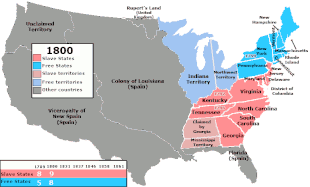
Slaverywas established as a legal institution in each of theThirteen Colonies,starting from 1619 onwards with the arrival of"twenty and odd"enslaved Africans inVirginia.Althoughindigenous peopleswere also sold into slavery, the vast majority of the enslaved population consisted of Africans brought to the Americas via theAtlantic slave trade.Due to a lower prevalence oftropical diseasesand bettertreatment,the enslaved population in the colonies had a higher life expectancy than in theWest Indiesand South America, leading to a rapid increase in population in the decades prior to theAmerican Revolution.[1][2]Organized political and social movements toend slaverybegan in the mid-18th century.[3]The sentiments of theAmerican Revolutionand the promise of equality evoked by theDeclaration of Independencestood in contrast to the status of most black people, eitherfreeor enslaved, in the colonies. Despite this, thousands of black Americansfought forthePatriot causefor a combination of reasons. Thousands alsojoinedthe British, encouraged by offers of freedom such as thePhilipsburg Proclamation.[3]
In the 1770s, enslaved black people throughoutNew Englandbegan sending petitions to northernlegislaturesdemanding freedom. Five Northern states adopted policies to at leastgradually abolish slavery:Pennsylvaniain 1780,New HampshireandMassachusettsin 1783, andConnecticutandRhode Islandin 1784. TheRepublic of Vermonthad limited slavery in 1777, while it was still independent before it joined the United States as the 14th state in 1791. These state jurisdictions thus enacted the first abolition laws in theAtlantic World.[4]By 1804 (including New York (1799) and New Jersey (1804)), all of the Northern states had abolished slavery or set measures in place to gradually abolish it,[3][5]although there were still hundreds of ex-slaves working without pay as indentured servants in Northern states as late as the 1840 census (seeSlavery in the United States#Abolitionism in the North).
In the South,Kentuckywas created as a slave state from Virginia (1792), andTennesseewas created as a slave state fromNorth Carolina(1796). By 1804, before the creation of new states from the federal western territories, the number of slave and free states was eight each. By the time ofMissouri Compromiseof 1820, the dividing line between the slave and free states was called theMason-Dixon line(betweenMarylandand Pennsylvania), with its westward extension being theOhio River.
The 1787Constitutional Conventiondebated slavery, and for a time slavery was a major impediment to passage of thenew constitution.As a compromise, slavery was acknowledged but never mentioned explicitly in the Constitution. TheFugitive Slave Clause,Article 4, section 2, clause 3, for example, refers to a "Person held to Service or Labour." In addition,Article 1, section 9, clause 1 of the Constitutionprohibited Congress from abolishing theimportation of slaves,but in a compromise, the prohibition could be lifted by Congress in 20 years, and slaves were referred to as "Persons." TheAct Prohibiting Importation of Slavespassed easily in 1807 and took effect on January 1, 1808. However, the ban on importation spurred an expansion in thedomestic slave trade,which remained legal until slavery was banned entirely in 1865 by the13th Amendment.

In the late 1850s an unsuccessful campaign was launched by several southern states to resume the international slave trade, to restock their slave populations, but this met with strong opposition.[6]However, there was a large natural increase in the slave population throughout the late 18th and 19th centuries, while some illegal smuggling of African slaves continued viaSpanish Cuba.[citation needed]
One of the other compromises of the Constitution was the creation of theThree-Fifths Clauseby which slave states acquired increased representation in theHouse of RepresentativesandElectoral Collegeequivalent to 60 percent of theirdisenfranchisedslave populations. Slave states had wanted 100 percent of their slaves to be counted, whereas Northern states argued that none should be.
New territories
[edit]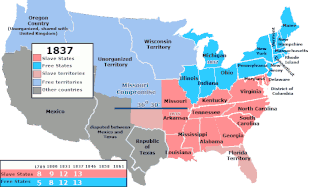
TheNorthwest Ordinanceof 1787, passed just before theU.S. Constitutionwas ratified, had prohibited slavery in the federalNorthwest Territory.The southern boundary of the territory was theOhio River,which was regarded as a westward extension of theMason-Dixon line.The territory was generally settled byNew EnglandersandAmerican Revolutionary Warveterans granted land there.[citation needed]The 6 states created from the territory were all free states:Ohio(1803),Indiana(1816),Illinois(1818),Michigan(1837),Wisconsin(1848), andMinnesota(1858).[7]
By 1815, the momentum for antislavery reform appeared to run out of steam, with half the states having already abolished slavery (Northeast), prohibited it from the start (Midwest), or committed to eliminating it, and half committed to continuing the institution indefinitely (South).
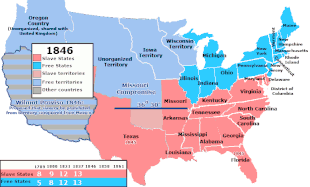
The potential for political conflict over slavery at the federal level made politicians concerned about the balance of power in theSenate,where each state was represented by two senators. With an equal number of slave states and free states, the Senate was equally divided on issues important to theSouth.As the population of the free states began to outstrip the population of the slave states, leading to control of theHouse of Representativesby free states, the Senate became the preoccupation of slave-state politicians interested in maintaining a congressional veto over federal policy with regard to slavery and other issues important to the South. As a result of this preoccupation, slave states and free states were often admitted into the Union in opposite pairs to maintain the existing Senate balance between slave and free states.
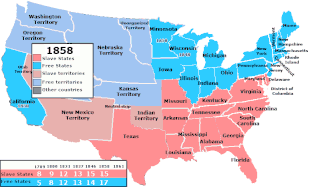
Missouri Compromise
[edit]Controversy over whetherMissourishould be admitted as a slave state resulted in theMissouri Compromiseof 1821, which specified that territory acquired in theLouisiana Purchasenorth of latitude 36° 30', which described most of Missouri's southern border, would, except for Missouri, become free states, and territory south of that line would become slave states. As part of the compromise,Maine,on August 19, 1821, was admitted as a free state.[8]
Texas and the Mexican Cession
[edit]Theadmission of Texas(1845) and the acquisition of the vast newMexican Cessionterritories (1848), after theMexican–American War,created further north–south conflict. Although the settled portion of Texas was an area rich incotton plantationsand dependent on slave labor, the territory acquired in theMountain Westdid not seem hospitable tocottonor slavery.[9]
As part of theCompromise of 1850,California was admitted as a free state without a slave state being admitted; California's admission also meant there would be no slave state on the Pacific coast. To avoid creating a free state majority in the Senate, California agreed to send one pro-slavery and one anti-slavery senator to Congress.[10]
Last battles
[edit]The difficulty of identifying territory that could be organized into additional slave states stalled the process of opening the western territories to settlement. Slave-state politicians made efforts to annexCuba(see:Lopez ExpeditionandOstend Manifesto,1852) andNicaragua(see:Filibuster War,1856–57), with intentions to create new slave states. Parts ofNorthern Mexicowere also coveted, with SenatorAlbert Browndeclaring "I wantTamaulipas,Potosi,and one or two otherMexican States;and I want them all for the same reason – for the plantation and spreading of slavery ".[11]
Kansas
[edit]In 1854, the Missouri Compromise of 1820 was superseded by theKansas–Nebraska Act,which allowed white male settlers in the new territories to determine, by vote (popular sovereignty), whether they would allow slavery within each territory. The result was that pro- and anti-slavery elements flooded into Kansas with the goal of voting slavery up or down, leading tobloody fighting.[12]An effort was initiated to organizeKansasfor admission as a slave state, paired withMinnesota,but the admission of Kansas as a slave state was blocked because its proposed pro-slavery constitution (theLecompton Constitution) had not been approved in an honest election. Anti-slavery proponents during the "Bleeding Kansas"period of the later 1850s were calledFree-StatersandFree-Soilers,and fought against pro-slaveryBorder Ruffiansfrom Missouri. The animosity escalated throughout the 1850s, culminating in numerous skirmishes and devastation on both sides of the question. Nevertheless, the North prevented Kansas Territory from becoming a slave state, and when Southern members of Congress departeden massein early 1861, Kansas was immediately admitted to the Union as a free state.
When the admission of Minnesota proceeded unimpeded in 1858, the balance in the Senate ended; this was compounded by the subsequent admission ofOregonas a free state in 1859.
Slave and free state pairs
[edit]The following table shows the balance between slave and free states that began in 1812. The Statehood columns provide the year the state either ratified the U.S. Constitution or wasadmitted to the Union.[13]The date ranges in the Abolition column for Free States indicate when gradual abolition laws were adopted and when slavery finally ended, except for states where slavery was outlawed in a specific year.[14][15]
| Slave States | Statehood | 1860,# and % of population in slaves | Free States | Statehood | Free state immediate or gradual abolition and1860% | |
|---|---|---|---|---|---|---|
| Delaware | 1787 | 1,798 – 1.6% | New Jersey | 1787 | 1804–65 – 0.01% | |
| Georgia | 1788 | 462,198 – 43.7% | Pennsylvania | 1787 | 1780–1840s – 0% | |
| Maryland | 1788 | 87,189 – 12.7% | Connecticut | 1788 | 1784–1840s – 0% | |
| South Carolina | 1788 | 402,406 – 57.2% | Massachusetts | 1788 | Free 1783 – 0% | |
| Virginia | 1788 | 490,865 – 30.7% | New Hampshire | 1788 | 1783–1800, Free 1857 – 0% | |
| North Carolina | 1789 | 331,059 – 33.4% | New York | 1788 | 1799–1840s – 0% | |
| Kentucky | 1792 | 225,483 – 19.5% | Rhode Island | 1790 | 1784–1840s – 0% | |
| Tennessee | 1796 | 275,719 – 24.8% | Vermont | 1791 | Free 1777 – 0% | |
| Louisiana | 1812 | 331,726 – 46.9% | Ohio | 1803 | Free 1787 – 0% |

From 1812 through 1850, maintaining the balance of free and slave state votes in the Senate was considered of paramount importance if theUnionwere to be preserved, and states were typically admitted in pairs:
| Slave states | Year | Free states | Year | |
|---|---|---|---|---|
| Mississippi | 1817 | Indiana | 1816 | |
| Alabama | 1819 | Illinois | 1818 | |
| Missouri | 1821 | Maine | 1820 | |
| Arkansas | 1836 | Michigan | 1837 | |
| Florida | 1845 | Iowa | 1846 | |
| Texas | 1845 | Wisconsin | 1848 |
California was admitted as a free state in 1850 without an accompanying slave state, though certain concessions were made to the slave states as part of theCompromise of 1850.Three more free states were admitted in the final years before the Civil War, disrupting the balance that the slave states had tried to maintain.
| Slave states | Year | Free states | Year | |
|---|---|---|---|---|
| California | 1850 | |||
| Minnesota | 1858 | |||
| Oregon | 1859 | |||
| Kansas | 1861 |
Civil War
[edit]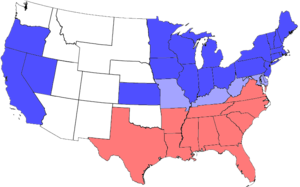
TheAmerican Civil War(1861–1865) disrupted and eventually ended slavery. Eleven slave states joined theConfederacy,while theborder statesof Delaware, Maryland, Kentucky, and Missouri – all slave states – remained in the Union, although Kentucky and Missouri also had competing Confederate state governments. In 1863 western Virginia, much of which had remained loyal to the Union, was admitted as the new state ofWest Virginiawith a commitment to gradual emancipation. The following yearNevada,a free state in the West, was also admitted.
| Slave state | Year | Free state | Year | |
|---|---|---|---|---|
| West Virginia (gradual abolition plan) |
1863 | Nevada | 1864 |
Special cases
[edit]West Virginia
[edit]During the Civil War, aUnionist governmentinWheeling, Virginia,presented a statehood bill to Congress to create a new state from 48 counties in western Virginia. The new state would eventually incorporate 50 counties. The issue of slavery in the new state delayed approval of the bill. In the SenateCharles Sumnerobjected to the admission of a new slave state, whileBenjamin Wadedefended statehood as long as a gradual emancipation clause would be included in the new state constitution.[16]Two senators represented the Unionist Virginia government,John S. CarlileandWaitman T. Willey.Senator Carlile objected that Congress had no right to impose emancipation onWest Virginia,while Willey proposed a compromise amendment to the state constitution for gradual abolition. Sumner attempted to add his own amendment to the bill, which was defeated, and the statehood bill passed both houses of Congress with the addition of what became known as the Willey Amendment. President Lincoln signed the bill on December 31, 1862. Voters in western Virginia approved the Willey Amendment on March 26, 1863.[17]
President Lincoln had issued theEmancipation Proclamationon January 1, 1863, which exempted from emancipation theborder states(four slave states loyal to theUnion) as well as some territories occupied by Union forces within Confederate states. Two additional counties were added to West Virginia in late 1863,BerkeleyandJefferson.The slaves in Berkeley were also under exemption but not those in Jefferson County. As of the census of 1860, the 49 exempted counties held some 6000 slaves over 21 years of age who would not have been emancipated, about 40% of the total slave population.[18]The terms of the Willey Amendment only freed children, at birth or as they came of age, and prohibited the importation of slaves.[19]
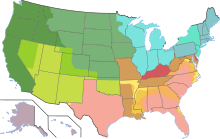
West Virginia became the 35th state on June 20, 1863, and the last slave state admitted to the Union.[20][21][22]Eighteen months later, the West Virginia legislature completely abolished slavery,[23]and also ratified the13th Amendmenton February 3, 1865.
Washington D.C.
[edit]In theDistrict of Columbia,formed with land from two slave states, Maryland and Virginia, the trade was abolished by theCompromise of 1850.So as to avoid losing the profitable slave trading businesses in Alexandria (one wasFranklin and Armfield), Alexandria County, D.C., requested that it be returned to Virginia, where the slave trade was legal; this took place in 1847. Slavery in the District of Columbia remained legal until 1862, when Southern members of Congress resigned, enabling those remaining to pass the ban, whichabolitionistshad been seeking for decades.[citation needed]
Utah Territory
[edit]Although it did not become a state until 1896, as anorganized territory,Utah legalized slavery under the 1852 territorialAct in Relation to Serviceand similarAct for the Relief of Indian Slaves and Prisoners.
Brigham Youngand his group ofMormonpioneers had arrived in Utah in 1847, during theMexican–American War,whenUtah Territorywas Mexican territory. They ignored the Mexican ban on slavery.They viewed slaveryas consistent with the Mormon view on Black people.[24]
On June 19, 1862, fulfilling a part of his1860 campaignplatform, President Lincoln signed the law ending slavery in Utah Territory and all other territories.[25]
California
[edit]While California's state constitution outlawed slavery, the 1850Act for the Government and Protection of Indiansallowed the indenture of Native Californians.[26]This law provided for "apprenticing" or indenturing Indian children to Whites, and also punished "vagrant" Indians by "hiring" them out to the highest bidder at a public auction if the Indian could not provide sufficient bond or bail.[27]White settlers took 10,000 to 27,000 California Native Americans as forced laborers, including 4,000 to 7,000 children.[28][29]In April 1863, after the declaration of theEmancipation Proclamation,the California legislature abolished all forms of legal indenture and apprenticeship for Native Americans.[30]
End of slavery
[edit]At the start of the Civil War, there were 34 states in the United States, 15 of which were slave states. Eleven of these slave states, after conventions devoted to the topic, issued declarations of secession from the United States, created theConfederate States of America,and were represented in theConfederate Congress.[31][32]The slave states that stayed in the Union – Maryland, Missouri, Delaware, and Kentucky (calledborder states) – retained their representatives in the U.S. Congress. By the time theEmancipation Proclamationwas issued in 1863, Tennessee was already under Union control.[33]Accordingly, the Proclamation applied only in the 10 remaining Confederate states. During the war, abolition of slavery was required by PresidentAbraham Lincolnfor readmission of Confederate states.[34]
TheU.S. Congress,after the departure of the powerful Southern contingent in 1861, was generally abolitionist: In a plan endorsed by Abraham Lincoln, slavery in theDistrict of Columbia,which the Southern contingent had protected, was abolished in 1862.[35]
In Southern states, freedom for slaves typically followed the Union army's gaining control of an area. TheEmancipation Proclamationdeclared all enslaved people in areas then under Confederate control free, but, in practice, freedom required either slaves reaching Union lines or Union forces reaching their area. As Union forces advanced from January 1, 1863, toJune 19, 1865,slaves were freed.
West Virginia did not abolish slavery in its first proposed constitution of 1861, though it did ban the importation of slaves.[36]In 1863, voters approved the Willey Amendment, which provided for gradual abolition of slavery, with the last enslaved people scheduled to be freed in 1884.[37]On February 3, 1865, the state legislature approved immediate abolition.[38]
TheRestored Government of Virginia– the Unionist government that governed the limited territory then under Union control that had not left to formWest Virginia– voted to end slavery at a constitutional convention on March 10, 1864.[39]Arkansas, part of which came under Union control by 1864, adopted an anti-slavery constitution on March 16, 1864.[40] Louisiana – much of which had been under Union control since 1862 – abolished slavery through a new state constitution approved by voters September 5, 1864.[41]The border states of Maryland (November 1, 1864)[42]and Missouri (January 11, 1865)[43]abolished slavery before the war's end. The Union-occupied state of Tennessee abolished slavery by popular vote on a constitutional amendment that took effect February 22, 1865.[44]
However, slavery legally persisted in Delaware,[45]Kentucky,[46]and (to a very limited extent, due to a trade ban but continued gradual abolition) New Jersey,[47][48]until theThirteenth Amendment to the United States Constitutionabolished slavery throughout the United States, except as punishment for a crime, on December 18, 1865, ending the distinction between slave and free states.[49]As such, slavery in the United States technically existed longer in the North than in the South.
See also
[edit]- Border states (American Civil War)
- Golden Circle (proposed country)
- Quilombo
- Slavery in the colonial United States
- Slavery in the United States
- Wilmot Proviso
- History of slavery in the United States by state
References
[edit]- ^Painter, Nell Irvin (2006).Creating Black Americans: African-American history and its meanings, 1619 to the present.New York: Oxford University Press. pp. 23–24.ISBN0-19-513755-8.OCLC57722517.
- ^Betty Wood,Slavery in Colonial America, 1619–1776(2013)excerpt and text search
- ^abcPainter, Nell Irvin(2006).Creating Black Americans: African-American History and Its Meanings, 1619 to the Present.Oxford University Press. pp.70–72.ISBN978-0195137569.
- ^Foner, Eric (2010).The Fiery Trial: Abraham Lincoln and American Slavery.New York: W. W. Norton & Company, Inc. p.14.ISBN978-0-19-513755-2.
- ^Wilson,Black Codes(1965), p. 15. "By 1775, inspired by those 'self-evident' truths which were to be expressed by theDeclaration of Independence,a considerable number of colonists felt that the time had come to end slavery and give the free Negroes some fruits of liberty. This sentiment, added to economic considerations, led to the immediate or gradual abolition of slavery in six Northern states, while there was a swelling flood of privatemanumissionsin the South. Little actual gain was made by the free Negro even in this period, and by the turn of the century the downward trend had begun again. Thereafter the only important change in that trend before the Civil War was that after 1831 the decline in the status of the free Negro became more precipitate. "
- ^William W. Freehling.The Road to Disunion, Volume II: Secessionists Triumphant, 1854–1861.Oxford University Press,2007, pp. 168–185.
- ^"LIBERTY! Northwest Ordinance".PBS.RetrievedJuly 5,2020.
- ^Mueller, Ken S. (2017)."Wolf by the Ears: The Missouri Crisis, 1819–1821 by John R. Van Atta".Journal of the Early Republic.37:173–175.doi:10.1353/jer.2017.0011.S2CID151453560.
- ^Michael A. Morrison, "Westward the Curse of Empire: Texas Annexation and the American Whig Party".Journal of the Early Republic10#2 (1990): 221–249online
- ^Michael E. Woods, "The Compromise of 1850 and the Search for a Usable Past."Journal of the Civil War Era9.3 (2019): 438–456.
- ^McPherson, James M.Battle Cry of Freedom: The Civil War Era.Oxford University Press, 2003. p. 105
- ^Nicole Etcheson.Bleeding Kansas: Contested Liberty in the Civil War Era.Lawrence, Kansas: University Press of Kansas, 2006, ch. 1.
- ^Leonard L. Richards,The Slave Power: The Free North and Southern Domination, 1780–1860(LSU Press, 2000).
- ^United States Census Bureau (1850). "5. Slave Population of the United States".Statistics of the United States(PDF).Suitland-Silver Hill, MD:United States Census Bureau.pp. 82–84.
- ^United States Census Bureau (1968). Cummings, John; Adna, Joseph (eds.).Negro Population in the United States, 1790–1915.New York: Arno Press. pp. 56–57.
- ^James Oakes,Freedom National: The Destruction of Slavery in the United States, 1861–1865,W. W. Norton, 2012, pp. 296–297.
- ^"West Virginians Approve the Willey Amendment".wvculture.org.RetrievedDecember 7,2015.
- ^"University of Virginia Library".virginia.edu.RetrievedDecember 7,2015.
- ^"Willey Amendment".wvculture.org.Archived fromthe originalon August 14, 2017.RetrievedDecember 7,2015.
- ^Alton Hornsby, Jr.,Black America: A State-by-State Historical Encyclopedia,Greenwood, 2011, vol. 2, p. 922.
- ^"West Virginia Statehood".wvculture.org.Archived fromthe originalon March 7, 2007.RetrievedDecember 7,2015.
- ^"African-Americans in West Virginia".wvculture.org.Archived fromthe originalon December 31, 2013.RetrievedDecember 7,2015.
- ^"On This Day in West Virginia History – February 3".wvculture.org.Archived fromthe originalon October 8, 2014.RetrievedDecember 7,2015.
- ^John Williams Gunnison(1852).The Mormons: Or, Latter-day Saints, in the Valley of the Great Salt Lake: a History of Their Rise and Progress, Peculiar Doctrines, Present Condition, and Prospects, Derived from Personal Observation, During a Residence Among Them.Lippincott, Grambo & Company. p.143.
Involuntary labor by negroes is recognized by custom; those holding slaves keep them as part of their family, as they would their wives, without any law on the subject. Negro caste springs naturally from their doctrine of blacks being ineligible to the priesthood
. - ^Arrington, Benjamin (June 19, 2018)."The Significance of June 19th".We're History.RetrievedJune 9,2022.
- ^Magliari, Michael (August 2004). "Free Soil, Unfree Labor".Pacific Historical Review.73(3). University of California Press: 349–390.doi:10.1525/phr.2004.73.3.349.ProQuest212441173.
- ^Ojibwa (March 2, 2015)."California's War On Indians, 1850 to 1851".Native American Netroots.Archived fromthe originalon April 13, 2019.
- ^Pritzker, Barry. 2000,A Native American Encyclopedia: History, Culture, and Peoples.Oxford University Press, p. 114.
- ^Exchange Team, The Jefferson."NorCal Native Writes Of California Genocide".JPR Jefferson Public Radio.Info is in the podcast. Archived fromthe originalon November 14, 2019.
- ^Magliari, Michael (2012)."Free State Slavery: Bound Indian Labor and Slave Trafficking in California's Sacramento Valley, 1850–1864".Pacific Historical Review.81(2): 190.doi:10.1525/phr.2012.81.2.155.JSTOR10.1525/phr.2012.81.2.155.
- ^Martis, Kenneth C. (1994).The Historical Atlas of the Congresses of the Confederate States of America, 1861–1865.Simon & Schuster. p. 7.ISBN0-02-920170-5.
- ^Only Virginia, Tennessee and Texas held referendums to ratify theirFire-Eaterdeclarations of secession, and Virginia's excluded Unionist county votes and included Confederate troops in Richmond voting as regimentsviva voce.Dabney, Virginius. (1983).Virginia: The New Dominion, a History from 1607 to the Present.Doubleday. p. 296.ISBN9780813910154.
- ^Eleven states had seceded, but Tennessee was under Union control.
- ^Guelzo, Allen C. (2018).Reconstruction: A Concise History.Oxford University Press. p. 4.ISBN978-0-19-086569-6.OCLC999309004.
- ^American Memory "Abolition in the District of Columbia",Today in History, Library of Congress, viewed December 15, 2014. On April 16, 1862, Lincoln signed a congressional act abolishing slavery in the District of Columbia with compensation for slave owners, five months before the victory at Antietam led to the Emancipation Proclamation.
- ^Lewis, Virgil Anson (1889).History of West Virginia: in two parts.pp. 379–380.RetrievedNovember 24,2021.
- ^West Virginia Legislature, House Concurrent Resolution 49, March 15, 2021
- ^"The Abolition of Slavery in Virginia".RetrievedNovember 21,2021.
- ^"Education from LVA: Convention Resolved to Abolish Slavery".edu.lva.virginia.gov.Archived fromthe originalon March 30, 2016.
- ^"Freedmen and Southern Society Project: Chronology of Emancipation".www.freedmen.umd.edu.University of Maryland.RetrievedNovember 26,2019.
- ^"Reconstruction: A State Divided".January 23, 2014.
- ^"Archives of Maryland Historical List: Constitutional Convention, 1864".November 1, 1864.RetrievedNovember 18,2012.
- ^"Missouri abolishes slavery".January 11, 1865. Archived fromthe originalon April 25, 2012.RetrievedNovember 18,2012.
- ^United States. Congress. Joint Committee on Reconstruction; United States. Congress (1866).Report of the Joint Committee on Reconstruction, at the First Session, Thirty-ninth Congress: Resolutions, committees, etc.U.S. Government Printing Office. pp. 10–.ISBN978-0-598-67518-7.OCLC17596217.
- ^"Slavery in Delaware".Slavenorth.com.RetrievedJanuary 21,2017.
- ^Harrison, Lowell H.; Klotter, James C. (1997).A New History of Kentucky.Lexington, Ky.: University Press of Kentucky. p. 180.ISBN0813126215.RetrievedOctober 16,2016.
- ^"Slavery in the Middle States (NJ, NY, PA)".Encyclopedia.com.July 16, 2020.RetrievedJune 19,2020.
- ^Smith, Geneva."Legislating Slavery in New Jersey".Princeton & Slavery.RetrievedJune 19,2020.
- ^Kocher, Greg (February 23, 2013)."Kentucky supported Lincoln's efforts to abolish slavery – 111 years late | Lexington Herald-Leader".Kentucky.com.Archived fromthe originalon July 2, 2018.RetrievedJanuary 21,2017.
Further reading
[edit]- Don E. Fehrenbacher and Ward M. Mcafee;The Slaveholding Republic: An Account of the United States Government's Relations to Slavery(2002)
- Rodriguez, Junius P.Slavery in the United States: A social, political, and historical encyclopedia(2 vol Abc-clio, 2007).
